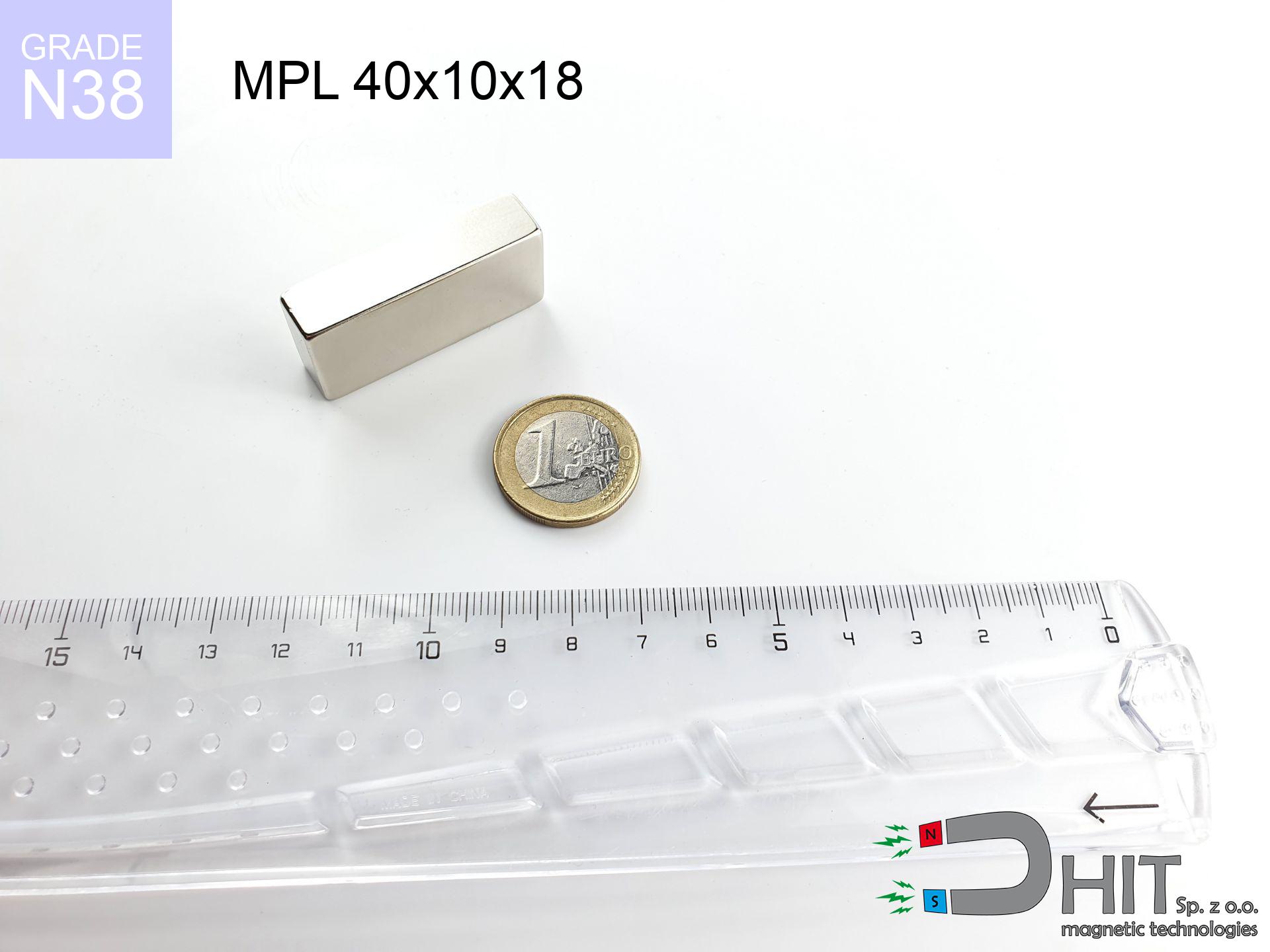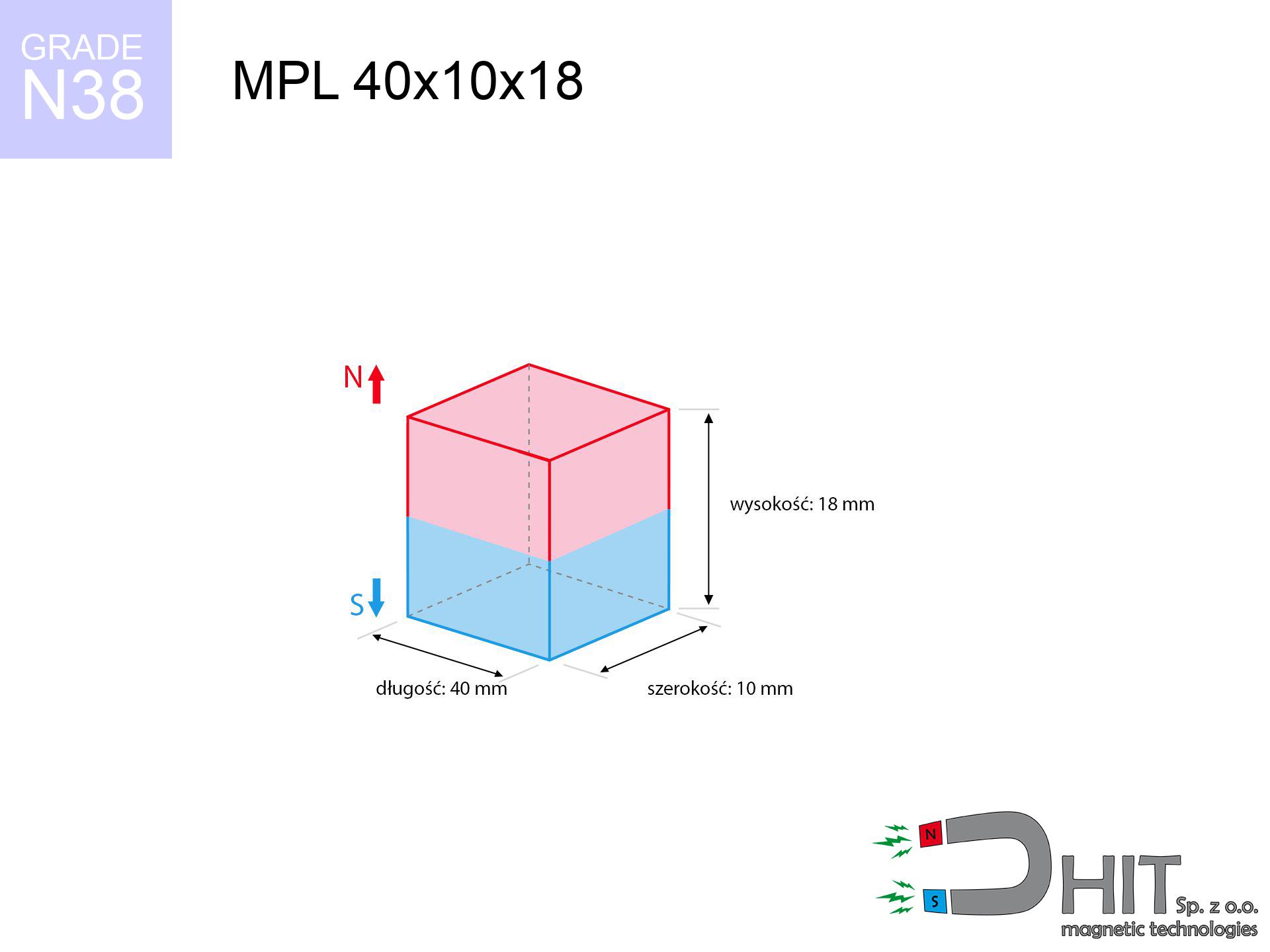MPL 40x10x18 / N38 - neodymium magnet
lamellar magnet
catalog number 020149
GTIN: 5906301811558
length
40
mm [±0,1 mm]
width
10
mm [±0,1 mm]
height
18
mm [±0,1 mm]
magnetizing direction
→ diametrical
capacity ~
28.43 kg / 278.80 N
magnetic induction ~
540.48 mT / 5,405 Gs
max. temperature
≤ 80
°C
catalog number 020149
GTIN: 5906301811558
length
40 mm [±0,1 mm]
width
10 mm [±0,1 mm]
height
18 mm [±0,1 mm]
magnetizing direction
→ diametrical
capacity ~
28.43 kg / 278.80 N
magnetic induction ~
540.48 mT / 5,405 Gs
max. temperature
≤ 80 °C
18.45 ZŁ gross price (including VAT) / pcs +
15.00 ZŁ net price + 23% VAT / pcs
bulk discounts:
need more quantity?Do you have a dilemma in choosing?
Call us tel: +48 22 499 98 98 or get in touch through contact form on the contact page. You can check the mass and the shape of neodymium magnets in our force calculator magnetic mass calculator
Orders placed by 2:00 PM will be shipped on the same business day.
Specification: lamellar magnet 40x10x18 / N38 → diametrical
Magnetic properties of the material N38
Physical properties of sintered neodymium magnets Nd2Fe14B
Due to their power, flat magnets are regularly used in products that require strong holding power.
Typical temperature resistance of these magnets is 80°C, but with larger dimensions, this value can increase.
Additionally, flat magnets commonly have special coatings applied to their surfaces, e.g. nickel, gold, or chrome, to increase their durability.
The magnet labeled MPL 40x10x18 / N38 i.e. a magnetic strength 28.43 kg weighing only 54.00 grams, making it the excellent choice for projects needing a flat magnet.
Contact surface: Due to their flat shape, flat magnets guarantee a greater contact surface with adjacent parts, which is beneficial in applications needing a stronger magnetic connection.
Technology applications: These are often utilized in many devices, e.g. sensors, stepper motors, or speakers, where the thin and wide shape is crucial for their operation.
Mounting: Their flat shape makes it easier mounting, particularly when it is necessary to attach the magnet to some surface.
Design flexibility: The flat shape of the magnets allows designers greater flexibility in arranging them in devices, which is more difficult with magnets of more complex shapes.
Stability: In certain applications, the flat base of the flat magnet may offer better stability, minimizing the risk of shifting or rotating. However, it's important to note that the optimal shape of the magnet depends on the specific application and requirements. In some cases, other shapes, such as cylindrical or spherical, are more appropriate.
Magnets have two poles: north (N) and south (S), which interact with each other when they are different. Poles of the same kind, e.g. two north poles, act repelling on each other.
Thanks to this principle of operation, magnets are often used in electrical devices, such as motors, speakers, sensors, or magnetic locks. Neodymium magnets stand out with the highest power of attraction, making them ideal for applications requiring powerful magnetic fields. Moreover, the strength of a magnet depends on its dimensions and the material it is made of.
It’s worth noting that extremely high temperatures, above the Curie point, cause a loss of magnetic properties in the magnet. Every magnetic material has its Curie point, meaning that once this temperature is exceeded, the magnet stops being magnetic. Additionally, strong magnets can interfere with the operation of devices, such as navigational instruments, credit cards or electronic devices sensitive to magnetic fields. For this reason, it is important to avoid placing magnets near such devices.
List recommended items
Advantages as well as disadvantages of neodymium magnets NdFeB.
Apart from immense strength, neodymium magnets have the following advantages:
- They do not lose strength over time - after approximately 10 years, their strength decreases by only ~1% (theoretically),
- They are extremely resistant to demagnetization by external magnetic field,
- By applying a shiny coating of nickel, gold, or silver, the element gains an aesthetic appearance,
- They have very high magnetic induction on the surface of the magnet,
- Thanks to their high temperature resistance, they can operate (depending on the form) even at temperatures up to 230°C and above...
- Thanks to the flexibility in shaping and the ability to adapt to specific requirements – neodymium magnets can be produced in a wide range of shapes and sizes, which amplifies their universality in usage.
- Significant importance in modern technologies – are used in HDD drives, electric motors, medical apparatus or other advanced devices.
Disadvantages of neodymium magnets:
- They can break as they are fragile when subjected to a strong impact. If the magnets are exposed to impacts, it is suggested using magnets in a steel housing. The steel housing in the form of a holder protects the magnet from impacts and also increases its overall strength,
- High temperatures can reduce the strength of neodymium magnets. Typically, after heating above 80°C, most of them experience a permanent loss in strength (although it is dependent on the form and size). To prevent this, we offer special magnets marked with the symbol [AH], which are highly resistant to high temperatures. They can operate even at temperatures up to 230°C, making them an ideal solution for applications requiring high-temperature operation,
- Magnets exposed to a humid environment can corrode. Therefore, when using them outdoors, we suggest using waterproof magnets made of rubber, plastic, or other moisture-resistant materials,
- Limited ability to create threads or complex shapes in the magnet - the use of a housing is recommended - magnetic holder
- Health risk to health from tiny fragments of magnets pose a threat, in case of ingestion, which becomes significant in the context of children's health. Furthermore, small elements of these products are able to be problematic in medical diagnosis when they are in the body.
Safety Precautions
Neodymium magnets are not recommended for people with pacemakers.
Neodymium magnets produce strong magnetic fields that can interfere with the operation of a heart pacemaker. Even if the magnetic field does not affect the device, it can damage its components or deactivate the entire device.
Dust and powder from neodymium magnets are highly flammable.
Avoid drilling or mechanical processing of neodymium magnets. If the magnet is crushed into fine powder or dust, it becomes highly flammable.
If you have a nickel allergy, avoid contact with neodymium magnets.
Studies clearly indicate a small percentage of people who suffer from metal allergies such as nickel. An allergic reaction often manifests as skin redness and rash. If you have a nickel allergy, you can try wearing gloves or simply avoid direct contact with nickel-plated neodymium magnets.
Neodymium magnets are over 10 times stronger than ferrite magnets (the ones in speakers), and their power can surprise you.
Please review the information on how to handle neodymium magnets and avoid significant harm to your body, as well as prevent unintentional damage to the magnets.
Do not give neodymium magnets to children.
Not all neodymium magnets are toys, so do not let children play with them. In such a situation, surgery is necessary to remove them. In the worst case scenario, it can result in death.
Under no circumstances should neodymium magnets be placed near a computer HDD, TV, and wallet.
The strong magnetic field generated by neodymium magnets can damage magnetic media such as floppy disks, video tapes, HDDs, credit cards, magnetic ID cards, cassette tapes, or other devices. They can also destroy videos, televisions, CRT computer monitors. Remember not to place neodymium magnets close to these electronic devices.
Neodymium magnets can demagnetize at high temperatures.
Under specific conditions, Neodymium magnets can lose their magnetism when subjected to high temperatures.
Magnets made of neodymium are delicate as well as can easily break and shatter.
Neodymium magnets are characterized by significant fragility. Neodymium magnets are made of metal and coated with a shiny nickel surface, but they are not as hard as steel. In the event of a collision between two magnets, there may be a scattering of fragments in different directions. Protecting your eyes is crucial in such a situation.
Avoid bringing neodymium magnets close to a phone or GPS.
Magnetic fields can interfere with compasses and magnetometers used in aviation and maritime navigation, as well as internal compasses of smartphones and GPS devices. There are neodymium magnets in every smartphone, for example, in the microphone and speakers.
It is crucial not to allow the magnets to pinch together uncontrollably or place your fingers in their path as they attract to each other.
In the situation of holding a finger in the path of a neodymium magnet, in such a case, a cut or a fracture may occur.
In order to illustrate why neodymium magnets are so dangerous, see the article - How very dangerous are very strong neodymium magnets?.




![magnetic beam 950x180x70 [4x M8] magnetic beam 950x180x70 [4x M8]](https://cdn3.dhit.pl/graphics/products/bm-950x180x70-4x-m8-ves.jpg)



